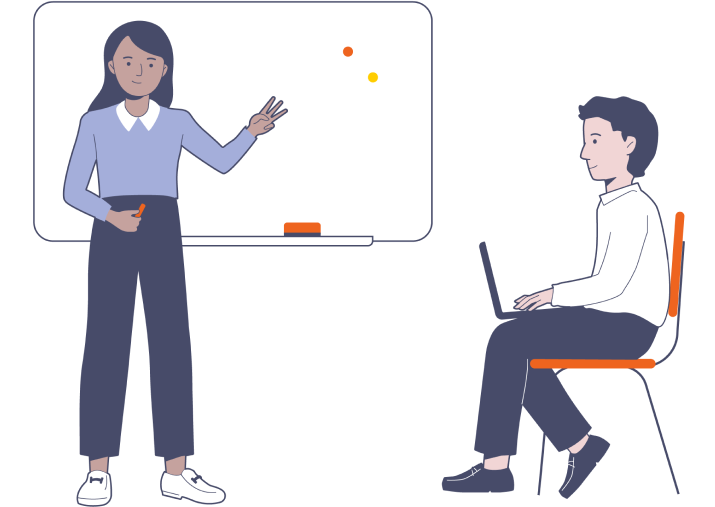
Responsive Coaching Interview with Josh Goodrich and Kat Howard Part 2
Resources|11th June 2024

PD Specialist — Steplab

Co-Founder & CEO — Steplab
Josh and Kat delve into the structure of Josh's book and some common questions about implementing a coaching programme across a school or trust.
In Part 2 of this interview, Josh and Kat delve into the structure of Josh's book and some common questions about implementing a coaching programme across a school or trust. Watch the full webinar here.
Kat: Can you tell us about why you decided to structure the book in the three sections: Theory, Practice, and Implementation?
Josh: I wanted the book to be a responsive read. Whether you're a complete beginner, an experienced coach, or a leader, my sense is that you have to read and understand the Theory section to understand the why. The Practice section is formed by the five change catalysts I spoke about in part 1, one in each chapter, and these are standalone chapters.
What I hope is that readers can think about which aspects of coaching they want to get better at and then those chapters will relate. If you want to be better at talking about the evidence in a lesson you can read the Awareness chapter. If you want to get better at rehearsal you can skip all the way to the end and read the Habits chapter. If you want to be better at modelling steps then read the Steps chapter. In this way, it’s a bit of a choose-your-own-adventure. Finally, if you’re a school leader you have to know how to implement effectively and how to build the culture you need. Therefore, the third section of the book is on implementation.
Kat: I also really appreciated the case studies in the book. Your vignettes are really concise and clear. The book takes us from a really sophisticated conceptual idea to what this looks like as a lived reality, as a teacher, through the vignette. I know Steplab has thought a lot about effective implementation of coaching. What are the common pitfalls and how do we implement coaching really effectively?
Josh: I think there are four things that can go wrong with implementation: four persistent challenges. You can view them as steps on a journey.
- 1.Culture- The first is that schools must start with a trusting culture. If people are frightened, if people are defensive, if people have been hurt by leaders or coaches before, the coaching programme is absolutely not going to work. So the very first job is to set that culture. And you don't set that culture by doing coaching, importantly. You set that culture by doing other stuff.
- 2.Training - Once that culture is in place, step two on the journey is training your team. Coaching is difficult and it’s not easy to be a good coach. I happen to think that, as a former school leader, that training as many people as possible in my school to be great teacher educators is probably the most valuable thing that I can do. But it's also a lot of work. And without people that know how to coach, who have read Responsive Coaching from cover to cover and done lots of practice, it's not going to work. So there is a training requirement there. You need to build your culture. You need to train your team.
- 3.Systems - The third challenge is to build systems where coaching can flourish. And this is basically a de-implementation process. There is probably not going to be space for coaching to happen at the moment, but there will be a load of other meetings and things that are filling up people’s time and not doing people very much good. Strip those away and make room for people to have professional conversations about how to be better teachers.
- 4.Responsive Leadership - The fourth one is looking at those three and seeing where it's going wrong – because it will go wrong – and then making changes. That's responsive leadership.
Building a great coaching programme is not something that can be rushed. You can't just go from zero, from September, “Let's do coaching” to coaching in October, unless your school already has a ton of stuff in place.
It could take you six months to set your culture up. It could take you a year. But if you do that, and you are taking steps as a leader to build a better school culture where teachers are having conversations about teaching, learning, and they're visiting each other's lessons, your school is going to get better, even if you haven't begun coaching yet. That's called in the research a “spillover effect.”
There is really robust research that building culture, a culture of peer coaching in school, and training teachers to be teacher educators, and making space for peer coaching to run, makes teachers better in a school, even if they are not getting coaching themselves.
What that tells us is that the journey to building a great coaching programme might take a long time but it is making a school better on top of the individual power of the coaching conversations themselves. I've seen that in my own practice. To summarise, it doesn't matter if it's hard to get there, because the journey there will have positive effects with each step you take.
Kat: Individual or group coaching: what are the main benefits of one-to-one over group coaching conversations?
Josh: I think group coaching is a critically important step in building a coaching programme but I also don't think it's coaching. I think it’s clear that in the surface definition of coaching, it's two people. One of the really powerful things about coaching is someone supporting you to implement for just you and your context and I don't think that can happen in group coaching. Now, that's not to say that group coaching is not brilliant because it is, but it does a different job. Group coaching sets the rail tracks – it builds teacher knowledge very effectively. For example, teaching a technique clearly to a group with modelling and rehearsal. A modelling and rehearsal-based group PD is the perfect pre-ingredient for coaching to absolutely fly. But for real lasting change, you need the help of someone in your context.
Kat: In your book, you talk about the danger of using opinion-based language in coaching. Can you expand on this, or give any further advice to ensure that we’re using data-driven language instead?
Josh: Lots of coaches will be in the habit of pointing out things in the lesson and thinking they're being really positive, for example: ‘The stuff I absolutely loved in your lesson was...’ It’s important to move away from this and replace it with language of impact. For example: “It was really effective when…” “What was the impact of…?” This matters because it's not about the coach being the arbiter of what good is. Coaching is not about pleasing your coach, it's about what’s working in the classroom and benefiting student learning. Therefore, we need to draw attention to that, not what the coach thinks.
Secondly, it’s important to gather concrete evidence from the classroom such as writing down specific things teachers or students say and do. Noting things down from student work and then like really skillfully talking about what you notice and asking the teacher questions about that. Photos work well, and If it's the culture and people have agreed, video can help too. Then the coach can ask: "I noticed… here’s some evidence, Tell me about this." There's no emotion there. There's no indication if this is bad or good.
Use more data-driven language and avoid opinions, think about the use of the language of impact and focus on concrete evidence gathering.
Kat: Another question is around defining what a good mental model is. I imagine many coaches can have many misconceptions about what is good for students. How do we ensure coaches pick the right thing for teachers to work on?
Josh: This is hard! I'm unapologetic in the book that responsive coaching requires coaches to have good knowledge. Responsive coaching is a model of expert coaching that you should work towards. And one of the parts of expert coaching, probably the hardest part, is watching a teacher in practice and making a good diagnostic decision. In the book, I used Willingham’s simple model of memory and Oli Cav’s update of it, which he then did a further update on. This diagram becomes a kind of a diagnostic rule of thumb.

For example, if you're watching a teacher teach, the first thing to look for is have they secured student attention? In the book I list all the specific things you might want to see there.
If that’s in place, the next thing you would look for is, is the teacher optimising their communication? If the teacher is communicating really clearly but every student is looking out the window, they might as well not be communicating clearly.
Let's say the teacher has secured student attention and has optimised their communication, the next thing we’d look for is that they would be driving student thought. Because of course a lesson where we get all the students' attention, talk at them for an hour and then they go home, no one's learning anything, no one’s done any thinking. So secure attention, optimise communication, drive thought. Following this, there's a need to gather and give feedback. There's only a point in giving someone feedback on an aspect like their mini whiteboard routines, or any other method of gathering and giving feedback, if students have something they’ve already thought about. And finally, if we manage to nail it in all of the above, there's a need to ensure consolidation of that knowledge.
Attention → Communication → Thought → Feedback → Consolidation.
These strands are a sequential way of helping coaches to think through diagnosis. It helps to have this in your mind and think about what is the most foundational problem in the lesson and to begin your coaching there.
Kat: What do you think about having a coaching contract or agreement?
Josh: It’s vitally important that everyone who’s going to be involved in the coaching process is absolutely crystal clear from the outset on what is going to be required of them, what are they going to be having to do, what are they going to be part of.
That’s why the second to last chapter of this book is about 'Building a Culture of Trust' where I recommend a kind of charter. It's essentially a set of principles that teachers, leaders and coaches need to agree to for coaching to work. My suggestion would be that you could use this chapter to help you to ensure everyone sees these principles and then people can sign it. Having this upfront at the outset is super important to ensuring your coaching programme works.
Kat: Should we relate coaching to performance management, or give coaching first to teachers that require extra support?
Josh: My worry about this is that if teachers are told that they are getting a coach because they need support, it can be damaging. It creates a culture where other teachers think: “Oh, Jimmy’s getting coaching, but he needs support. I don't want coaching.” I would worry about that. My big solution for that is to give coaching to everyone. In this situation, the teacher who maybe needs a bit more support is also getting coaching and no one feels like they're being put on the spot. It’s for this reason that I write about approaching this kind of coaching model with caution in the book.
Kat: Is it possible to have a whole-staff approach to coaching?
Josh: Yes, in fact that's the only way I've ever done it in my schools. It’s not something you rush into but it’s good to work towards a peer coaching programme where every single person both gives and receives coaching. You can pair all teachers up, obviously being careful who you pair with who. For example, don’t pair two ITTs together as they won’t know what to talk about.
The point is, we're all learning how to coach and therefore there’s no pressure. Train teachers how to coach and have supports in place to help them. It's a journey where everyone's learning to coach at the same time. PD can then look something like an hour after school where everyone meets up in the hall, you receive some input on how to coach and then off you go, everyone has their coaching conversation. It feels brilliant and I think that's something great to definitely work towards.
However, I don't want to make that peer coaching programme sound easy. That's the whole point. It's not. You have to do so much work to get there and all of that work is good and benefiting your school. But you can’t start there; you need to build the culture first. You need to get all your coaches together and train them well. You need to decide what 'good' looks like in your school. *But when you do it, it's absolutely transformative.*
Key Takeaways:
- 1.There are challenges to the implementation of coaching that it’s important to spend time considering: Building the right culture, Training your Team, Building your systems, Responsive Leadership.
- 2.Group modelling and rehearsal can be a great stepping stone to successful coaching across a school.
- 3.It’s important to gather concrete evidence from the classroom and move away from opinion-based language in coaching.
You can find Part 1 of the interview between Josh and Kat here.
To speak to one of our team about how responsive coaching can supercharge your school or trust, get in touch to book a Steplab demo. To find out more about Responsive Coaching, order your copy of Steplab founder & CEO Josh's book Responsive Coaching.
Happy coaching!


